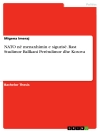This book offers a new look at international security management combining practical applications and theoretical foundations for new solutions to today’s complex security and safety challenges. The book’s focus on safety as a positive experience complements the traditional approach to safety as risks and threats. In addition, its multi-stakeholder, multi-disciplinary, international and evidence-based approach provides holistic and timely insights for the field. Topics raised in this book focus on the crucial questions of: Who is safety actually for? (and) How can sustainable safety solutions be jointly created?
This book provides comprehensive insights into the latest research findings, practical applications and suggestions for dealing with challenges in international security management in integrated and sustainable ways, making it relevant reading for practitioners, as well as academics and students – with a view to obtaining thorough, first-hand knowledge from serving experts in the field. We explore new ways of working with citizens, police and policymakers in order to co-create safety. This book emphasises the importance of safety as a topic that matters for all.
“Safety and security are basic pillars for the development of our society. However, the number of areas, actors and procedures involved in the management of the different elements composing the international security eco-system, its coordination and alignment, make it a challenging issue to resolve. This book provides a fresh new approach to this complex issue, in which we all have a role to play.”
Fernando Ruiz, Acting Head of European Cyber-Crime Centre – Europol
“A very timely analysis that brings a much-needed international perspective to the field of security management. The authors explore the challenges confronting security management in a complex and connected world and generate new ideas to support practice and inspire research.”
Professor Mark Griffin; John Curtin Distinguished Professor, Curtin University; Director, Future of Work Institute
“This book presents the role of International Security Management in the 21st century in an innovative way.”
Dr. Christian Endreß, Managing Director, ASW Bundesverband – German Association for Security in Industry and Commerce
İçerik tablosu
Foreword.- Introduction.- Part one: Setting the scene.- Chapter 1- Towards sustainable solutions in international security management – an introduction.- Introduction to Section 1. Conceptual perspectives on the international safety and security landscape.- Chapter 2- Security and safety: An integrative perspective.- Chapter 3- Positive safety.- Chapter 4- Managing
for Security.- Chapter 5- Trends on Security, Safety and Criminal Justice in the Netherlands.- Introduction to Section 2: How do we talk about security? Security narratives.- Chapter 6- What do people talk about when they talk about experiencing safety.- Chapter 7- When words make fences: a look into how words and media narratives contribute to the creation of a
fortress Europe.- Chapter 8- Welcome to the “shit show”: Leveraging emotions for theory building.- Chapter 9- Looking at safety and security issues in different cultures.- Chapter 10- Commonsecurity culture: myth or reality? Security co-creation from the risk management perspective: An essay based on observation, critical thinking and a strong belief in a better future.- Chapter 11- Artist’s reflections: The governance of safety and security as a performance’.- Introduction to Section 3: Grand security challenges.- Chapter 12- International security challenges of climate change: Lessons from the Syrian case for a multi-stakeholder approach to resilient adaptation.- Chapter 13- Target and Trigger. A reflection on the relation between cultural heritage and peace and security.- Part four: Organisational perspective.- Chapter 14- Emerging strategies to prevent Islamic radicalisation in Europe: Evidence from Italy.- Chapter 15- Illicit trade and private business.- Chapter 16- Finding safety in the smart city: A discourse analysis with strategic implications.- Chapter 17- Performance and participation in the panopticon: Instruments for civic engagement with urban surveillance technologies.- Chapter 18- Security and the new generation workforce.- Introduction to Section 4a: How do we organise security? Stakeholder perspectives.- Chapter 19- Business and corporate security: Contributing to a safer world’.- Chapter 20- Private security production.- Chapter 21- International security management in the Croatian police: Presenting a multi-faceted approach.- Chapter 22- Foresight-based Leadership. Decision making in a growing AI environment.- Chapter 23- Perceived opportunities and challenges of artificial intelligence within the police – a public management perspective’.- Chapter 24- A practice-based approach to security management: Materials, meaning and competence for trainers of healthcare cybersecurity.- Chapter 25- Local security governance in vulnerable residential areas’.- Chapter 26- Informational requirements to support positive safety lens policymaking.- Introduction to Section 4b: How do we organise security? Collaborations and networks.- Chapter 27- Collaborating across workplace boundaries: Recommendations based on identity research.- Chapter 28- Collaboration, unexpected events and governance in complex temporary organisations.- Chapter 29- The CBRN threat: Perspective of an inter-agency response.- Chapter 30- The practical realities of security management in a changing world.- Chapter 31- Countering criminal facilitation through public-private cooperation in the Netherlands.- Chapter 32- Cooperation and networking – a key to successful policing.- Introduction to Section 5: Implications for education and learning.- Chapter 33- Making waves through education: A method for addressing security grand challenges in educational contexts.- Chapter 34- A stroke of genius: Rembrandt’s “The Anatomy Lesson” as an inspiration for organising research for, about and in the world of policing.- Chapter 35- Blended co-design of education: The case of an executive master’s in security management.- Chapter 36- European Joint Master’s in Strategic Border Management: educational hub for international cooperation and networking in EU border management.- Chapter 37- The establishment of the international police relations section at the German police university – an investment in the present and the future.
Yazar hakkında
Professor Gabriele Jacobs is Professor in Organisational Behaviour and Dean of the Erasmus University College at Erasmus University, Netherlands. She derives her academic passion and inspiration from the collaboration and dialogue with inter-disciplinary academics and multi-sector practitioners, aiming to address core societal challenges to facilitate sustainable and innovative solutions. Her research interests lie in understanding the (organisational) impact of cultural factors, organisational justice and organisational identity. She publishes in a wide range of academic journals in organizational behaviour, marketing and management as well as in journals and books with an applied focus in the field of safety and security. She is involved in several national and EU-projects in the field of safety and security.
Dr Ilona Suojanen is an independent researcher and writer. She holds master degrees in journalism and educational sciences from universities in Finland and Australia and a Ph.D. from University of Edinburgh, UK. Her research interests lie in happiness and in visualising it, with a special focus on the impact of public safety on people’s wellbeing. She has written book chapters on happiness education and visualising happiness. She has received wide media interest in Finnish media, including the largest newspaper, Helsingin Sanomat and the Finnish equivalent of Economist, Kauppalehti on her work as a happyologist. Her passion is to ask relevant questions, find answers to them and then share her findings with wider audiences.
Dr Kate Horton is a Research Associate at Rotterdam School of Management, Erasmus University (RSM) and an Assistant Professor of Organisational Behaviour at the Federal University of Pernambuco, Brazil. In CESAM she is responsible for the research stream on ‘Identity’ which investigates how police identity and image influence collaboration, behavioural outcomes and stakeholder relations. Kate’s main research interests include workplace identities and identification, conflict and organisational change. She has published her research in a range of journals including Journal of Organizational Behavior, Social Issues and policy Review and Human Relations.
P. Saskia Bayerl is Professor of Digital Communication and Security at CENTRIC (Centre of Excellence for Terrorism, Resilience, Intelligence and Organised Crime Research), Sheffield Hallam University, UK. Her research interests lie at the intersection of human-computer interaction, organisational communication, and organisational change with a special focus on ICT innovations, privacy, and the management of transparency. She holds master degrees in psychology, linguistics and organizational dynamics from universities in Germany and the USA and a Ph.D. from Technical University in Delft, Netherlands. Her publications have appeared in international journals such as Communications of the ACM, MIS Quarterly and New Media and Society. She has further co-edited books on topics such as Open Source Intelligence, Application of Big Data for National Security and Community Policing.












